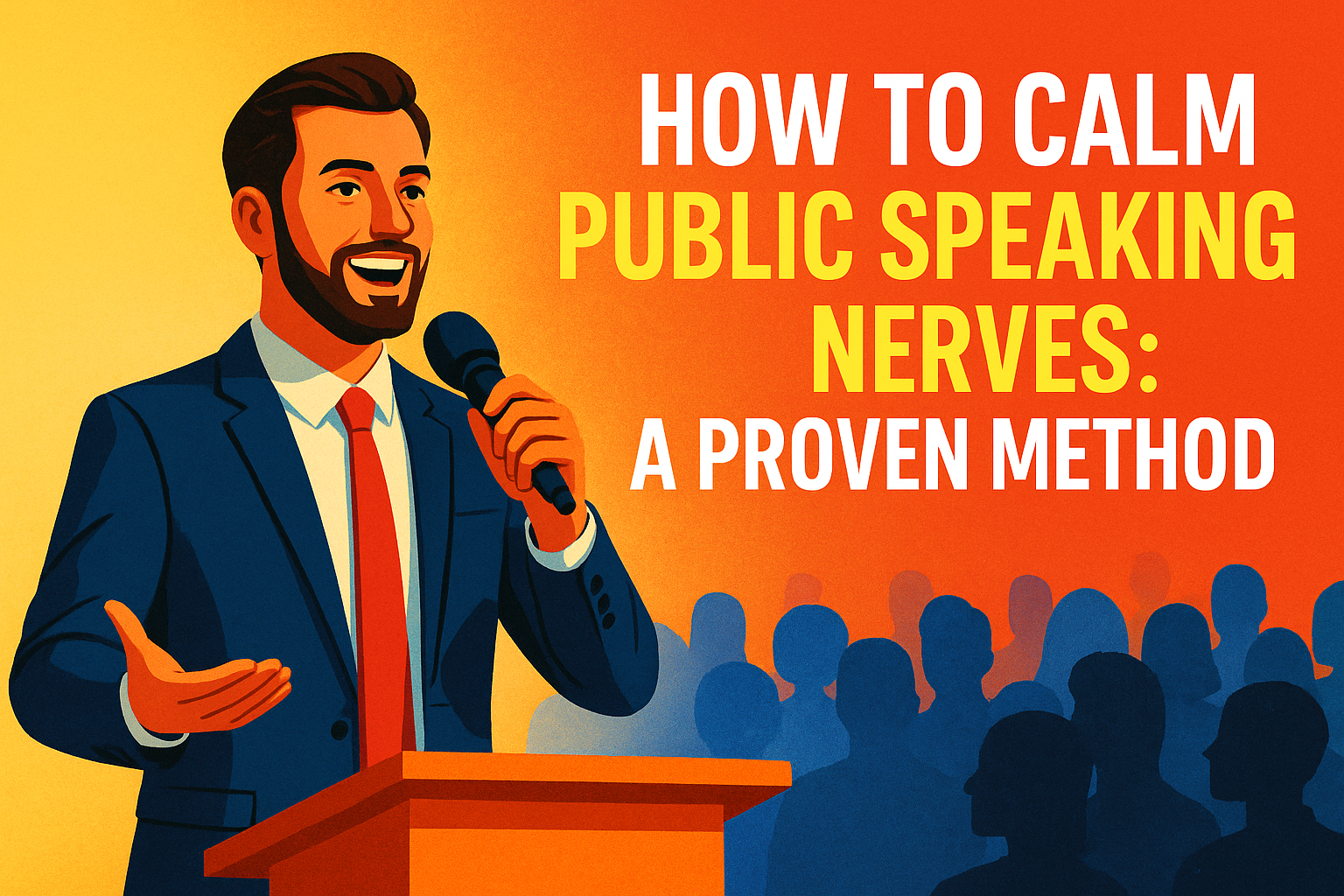Why Does the Fear of Public Speaking Arise?
Stage fright (glossophobia) is one of the most common anxiety disorders. Around 77% of people experience fear before public speaking. The main reasons are rooted in two factors:
- Fear of judgment. On a subconscious level, people are afraid of being rejected, mocked, or criticized. This fear is an evolutionary mechanism — being accepted by the group is essential for survival.
- Lack of preparation. A lack of practice and confidence increases anxiety. The brain reacts as if facing a real threat.
👉 Source: Harvard Business Review
Keywords:
public speaking, stage fright, how to stop fearing speeches, overcoming audience fear, breathing techniques, success visualization, how to speak confidently, stage stress, speaker tips, presentation preparation, billionaire experience
Technique 1: Visualization of Success
Visualization is a mental rehearsal technique where you imagine yourself delivering a successful presentation. Studies show that vivid mental images activate the same neural circuits as real-life experiences.
How to visualize effectively:
- Picture the whole process: stepping on stage, making eye contact, speaking clearly, receiving positive reactions from the audience.
- Add sensory details: feel the microphone, see the lights, hear the sounds, notice your breathing.
- Practice daily for 5–10 minutes.
Technique 2: Small Steps Method
Public speaking is a skill — like learning to ride a bike. Gradually increasing the challenge helps build confidence.
How to apply the small steps method:
- Start rehearsing in front of a mirror. Pay attention to gestures and facial expressions.
- Move on to performing in front of a friend or family member.
- Join an online speaking club or take part in mini-presentations at work.
- Track your micro-wins: this boosts motivation and reduces fear.
👉 More about the “small wins” principle — James Clear: The Power of Tiny Gains
Technique 3: Breathing and Body Control
Fear triggers physical symptoms: rapid heartbeat, shaking, dry mouth — the classic “fight or flight” response. To counter this, activate your parasympathetic system through breathing techniques.
Control practices:
- 4-4-8 Breathing:
- Inhale for 4 seconds.
- Hold for 4 seconds.
- Exhale slowly for 8 seconds.
- Repeat 10 cycles before your speech.
Progressive muscle relaxation and posture work (power poses) are also recommended.
👉 Scientific explanation of breathing techniques — Harvard Health Publishing
Technique 4: Video Analysis and Feedback
Recording your practice sessions allows you to see yourself from the outside — and correct mistakes. This boosts confidence and develops objective self-analysis skills.
How to apply:
- Record yourself on your smartphone.
- Analyze:
- Speech pace.
- Eye contact.
- Gestures.
- Clarity of speech.
- Share the video with a friend or mentor for feedback.
In essence, you are training metacognition — the ability to analyze your thoughts and behavior.
👉 Learn more: Metacognition Strategies from Edutopia
Technique 5: Prepare Your Opening
Fear is usually at its peak during the first 60 seconds. A well-prepared opening reduces anxiety.
Prepare in advance:
- A hook: a striking phrase, question, metaphor, or personal story.
- The first paragraph — memorize it nearly by heart.
- Your greeting and audience address.
Once you start strong, your fear will begin to fade.
👉 Ideas for openings — Toastmasters International Tips

Technique 6: Timed Rehearsals
Timing is key to a confident presentation. Regular practice with a stopwatch helps you:
- Control your time.
- Develop a rhythm for your speech.
- Eliminate unnecessary repetitions.
How to organize:
- Break your speech into blocks (intro, main part, conclusion).
- Time each block.
- Aim for a smooth, balanced flow.
👉 The Pomodoro Technique can help: Official Pomodoro Technique
Technique 7: Keep a Speaking Journal
Reflection is a crucial growth tool. After each speech (even a mini-presentation), note:
- What went well?
- What could be improved?
- Emotions before/after the speech.
- Audience reactions.
A speaking journal helps track your progress and reduces the emotional intensity of fear.
Format: notebook, smartphone notes, or Google Docs.
👉 Learn more about journaling benefits — Bullet Journal Method
How Billionaire MARGULAN SEYSEMBAY Overcame Stage Fright: A Tested Method from Personal Experience
In the early days of his career, billionaire Seysembay, like millions of others, suffered from paralyzing fear before stepping onto a stage. His hands trembled, his voice cracked, and his thoughts scattered like frightened birds leaving a nest. Every public appearance felt like torture — he felt panic inside and just wanted to escape.
But one day, a twist of fate changed everything.
Seysembay was invited to speak at a high-level event where the country’s president himself was in the audience. He agreed without much thought — unaware of the stress that lay ahead. But as he sat in the hall, looking at the powerful people before him, waves of adrenaline crashed through his body and chaos filled his mind. He was sure of one thing: this would be the end. The end of his reputation. The end of everything.
And then, fate intervened. Another speaker unexpectedly took the stage before him, giving Seysembay about 20 minutes of unexpected pause. And that’s when the miracle happened: after weathering the hormonal storm, his body began to calm. His thoughts cleared. The fear that had engulfed him vanished as suddenly as it had appeared. When his turn came, he stepped onto the stage and spoke effortlessly — not even understanding how.
Later, analyzing that moment, Seysembay realized a simple truth: fear is not your enemy — it’s just biochemistry. It’s all about adrenaline. When you’re scared, your body releases this hormone, causing trembling, confused thinking, and the desire to flee. But adrenaline can’t stay at peak levels for long. After 15-20 minutes, its level naturally drops — and clarity returns.
That’s when he developed his signature method.
Since then, Seysembay has used this technique consciously and taught it to others. He recalls the day when a young performer — a famous KVN comedian — came to him backstage before a major event, shaking with fear. Seysembay saw himself in that young man. And then he did something that seemed cruel: he painted the worst possible scenario. He told him he would fail, ruin his career, and be humiliated before the audience.
But there was a plan. The young man’s body released all the adrenaline at once. Twenty minutes later, he was as calm as stone. That night, the comedian delivered one of the best performances of his life.
“Don’t run from fear,” Seysembay says. “Make it your ally. Consciously scare yourself in advance. Imagine the worst possible outcome. Let the fear burn through your hormones before you go on stage. And when your moment comes — you’ll be calm, focused, and confident.”
This method has stayed with him to this day.
Source: YouTube channel of MARGULAN SEYSEMBAY. https://www.youtube.com/@Margulan.Seissembai
Conclusion: Practice Beats Perfectionism
Overcoming the fear of public speaking requires action. Systematic practice builds experience and neural connections — not just reading articles.
Use these 7 techniques as your personal plan. Start small. Allow yourself to make mistakes. Remember: insecurity is temporary.
🎁 Subscribe to our blog and download your free checklist

📊 Poll:
What scares you the most about public speaking?
🧑🤝🧑 A large audience
🎤 Starting the speech
🕒 Speaking time
❓ Questions from the audience
🧠 Forgetting your text





